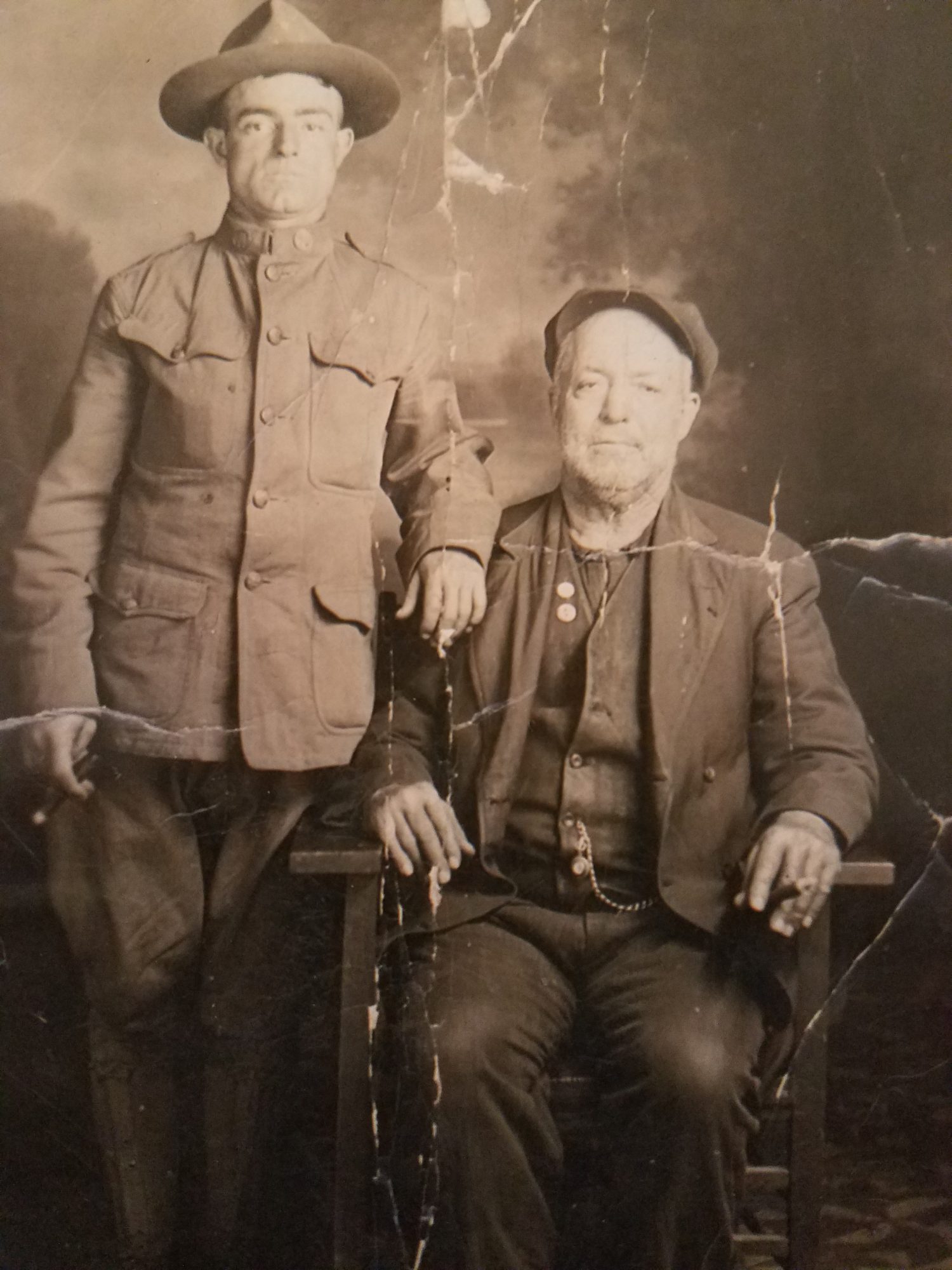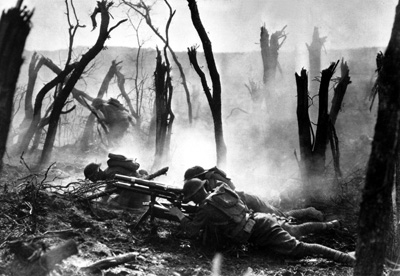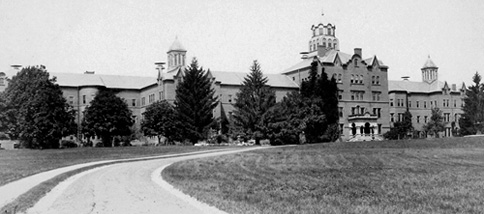100 Years Ago Today… A Soldier Returns: The Story of Charles Michaels
One hundred years ago today, on February 28, 1919, Private Charles J. Michaels boarded a troop ship in France, having fulfilled his brief duty as a soldier. Unfortunately, he returned home quite different compared to when he departed for the war front in June of 1918. This man was my great-uncle, brother of my grandfather.
Charles was born June 25, 1894 in Pittsfield, Massachusetts, the tenth of twelve children born to Peter and Amelia (Burnick) Michaels. He attended grade school in Pittsfield and by the time he was a teen, he started working in the local woolen mills and factories. This was typical for older children of low-income working class families during the early 1900’s. Looking back on his younger years, his mother said of Charles, “He was always strong and well as a child, and he had a cheerful disposition.”
As Charles grew into his adult years, he had an active social life and was known to have many friends. He enjoyed attending local dances, and was considered to be an excellent dancer himself. The Pittsfield authorities were quite familiar with Charles, as there were occasions when he would drink excessively, and this led to several arrests for drunkenness and fighting.
Like his father and grandfather, Charles continued to work as a weaver in the local woolen mills. He was employed for a time at the Pontoosuc Mill, earning $20.00 per week, but it seems this brought little satisfaction. When he was nineteen, he moved to Watertown, New York, where several of his siblings had settled. His time in Watertown was apparently brief, and by 1918, he was living in Bridgewater, south of Boston. During this time, he assisted his parents financially with $8.00 each week.
Although it’s unclear whether he enlisted, or was drafted, Charles entered the U.S. Army, being inducted into service on 27 April 1918 in Pittsfield. He then attended basic training at Camp Devens in Ayer, Massachusetts. After his training was completed, he enjoyed a short visit with family and friends, and then he departed for the war front in France.

June 1918 – just before Charles went to France
In July 1918, more than 300,000 American soldiers arrived in Europe and among them was Pvt. Charles Michaels, attached to Company A of the 301st Infantry Regiment. He disembarked from a troop carrier on 6 July, and within days, arrived in northeast France. Later, Charles was transferred to Company A of the 163rd Infantry Regiment, and then to Company I of the 167th Infantry Regiment. Portions of his service record are vague and incomplete, making some details difficult to confirm. However, Charles was credited with participation in four major engagements against the German Army including Champagne-Marne, Aisne-Marne, St. Mihiel, and Meuse-Argonne.
The Meuse-Argonne campaign began late in the evening of 25 September 1918 with the firing of long-range guns and an intensive artillery bombardment. The next morning, at 5:30 AM, officers signaled ‘forward’ and thousands of soldiers climbed out of the trenches and into a heavy fog to confront the enemy. Most of the fighting during this lengthy battle took place in rain and foggy darkness.

Incessant detonations, explosions, and small arms fire,
mingled with the screams of the wounded and dying.
By this time, Charles had been at the front for more than three months while serving under extreme battlefield conditions. Physical exhaustion, gruesome scenes of dead men, and the constant threat of personal gassing, maiming or death contributed to extreme levels of mental stress for the average soldier. In the Argonne Forest, these factors were compounded and combat conditions were incredibly intense. Individual soldiers had frequent encounters with the enemy at very close range and men often aimed and fired their weapons based on the location of enemy rifle or machine gun flashes. In addition, there were incessant detonations, explosions, and small arms fire, mingled with the screams of the wounded and dying.
The battlefield environment proved too intense and the service record of Pvt. Charles Michaels states he was, “Wounded severely 16 October 1918.”
There is no way to know exactly what happened to Charles on 16 October, but in the midst of the battle, he suffered a complete mental breakdown, a brain injury that destroyed his cognitive abilities. ‘Shell Shock’ became the common term to describe the acute psychosis that affected men’s minds as a result of battlefield experiences. Charles was one of 36,000 American World War I soldiers who were permanently affected by the condition.
Shell Shock is no longer diagnosed as a medical condition and it differs from what we have come to know today as Post Traumatic Stress Disorder, or PTSD. Both are a type of brain injury that results from having experienced the horrors of battle, but according to McDonald, et al, “the paraylsis and amnesia that epitomized WWI shell-shock cases are now so rare that they don’t even appear as symptoms (for PTSD).”
The timing of Charles’ injury was especially unfortunate. The following day, American forces broke through the German defenses on the Selle River. This turned the Meuse-Argonne engagement in favor of the allies, and led to the complete defeat of the German Army. The Armistice Agreement ending hostilities took effect twenty-six days later, on 11 November 1918.
Charles’ case of Shell Shock was very serious, with 100% disability status, but the condition of some men was even worse. On one occasion after the war, Mrs. Eleanor Roosevelt visited the mental ward at St. Elizabeth’s Hospital in Washington, D.C. There she saw, “Some men (WWI Veterans) who were chained to their beds, others unable to stop shouting of the horrors they had seen.”
Charles was admitted to Base Hospital #214 in Lyon, France, where he remained until returning to the U.S. He arrived in Norfolk, Virginia in March 1919 and was admitted to a military hospital. After examining Charles, a doctor recorded in his medical file, “mute, staring, swaying motion, pupils unresponsive.”
On 17 June 1919, Charles was transferred to the Northampton State Hospital in Northampton, Massachusetts. There, an official diagnosis was given: Dementia Praecox – Catatonic, which was ruled to be service-related. He received an honorable discharge from the Army, including a Surgeons Certificate which guaranteed his lifetime care as a disabled veteran.

Home to more than 700 disabled World War I veterans in the 1930s and 1940s
During the many years that followed, Charles was well cared for by the Veterans Bureau (later the Veterans Administration). Every conceivable need that Charles had was paid for at government expense, including housing, meals, clothing, and medical care. In addition, he received a monthly allotment that grew to a significant amount over the years.
Charles’ mental condition included substantial long-term memory loss, and at best, he was only vaguely aware of family relationships. However, his family continued to involve themselves in his life.
His sister Louisa would visit when possible, write letters, and occasionally place a telephone call. His brother William also attempted to correspond, but apparently became impatient when no answer came. In December 1938, William wrote to his congressman and another government official, requesting their assistance:
I would like to know what you can do for me. I have a brother in a hospital facility in Northampton, Massachusetts. He is a world war veteran and incompetent. The name of my brother is Charles J. Michaels. Now why is it I cannot receive an answer to letters to my brother? The early part of this year I registered a letter to him and it was never answered. About three weeks ago I sent him another letter and it never was answered. Hoping you will do something for me in this case. I remain,
Yours truly
William J. Michaels
Watertown, New York
Years went by, and it’s very safe to say that Charles adjusted to his daily routine. In spite of his poor mental health, his physical health was quite good. During an examination on 1 February 1961, his doctor wrote, “Since admission, there has been very little change in his condition.”
Other relatives, particularly nieces and nephews came to visit Charles from time to time, and some family members indicated that he was capable of brief and simple conversation. However, he continued to have very little remembrance of past events, or even the names of those who were close to him before his injury.
Charles’ world was quite small in many ways, being a resident of the Northampton Veterans Hospital for fifty-one years. In June 1975, Charles was transferred to the Spruce Manor Nursing Home in Springfield, Massachusetts.
A Veterans Administration caseworker visited Charles at the nursing home on 28 May 1976. He spent some time talking with him, to ensure that he was receiving adequate care and he interviewed the administrator of the home, as well as several nurses. The nursing staff indicated that Charles, “has no need at the present time for anything.”
The caseworker also wrote his observation of Charles. “… He is at least eighty years old, and has been institutionalized in various institutions since 1924. He is incapable of handling a rational conversation. He is in no condition to be able to handle his estate, or his monthly income. He has no understanding or knowledge of his income or estate…” He then summarized his findings by stating, “It would appear that this veteran is receiving all VA benefits to which he is entitled.”
Just two weeks later, on 11 June 1976, Charles passed away at the age of eighty-one after living with the effects of his unfortunate and devastating injury since he was twenty-four years old. He was buried in St. Michael’s Catholic Cemetery in Springfield, Massachusetts.

Awarded posthumously to Pvt. Charles J. Michaels
The World War I Victory Medal and Purple Heart were awarded posthumously and the military representative who processed the application said, “It is rare for any soldier to receive a victory medal with four battle clasps.” The back of the Purple Heart simply states:
For Military Merit
Charles J. Michaels
© Jeffery J. Michaels / Plain English Publications 2019
(Quotations allowed with attribution to this blog)
References:
US Army Veterans File of Charles J. Michaels
Federal Census 1910, Pittsfield, Massachusetts
From Shell-Shock to PTSD, a century of invisible war trauma. MaryCatherine Mc Donald, Marisa Brandt, and Robyn Bluhm. The Conversation.com. April 3, 2017.
